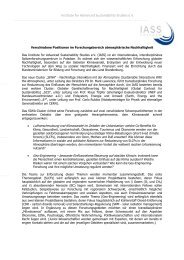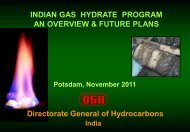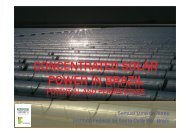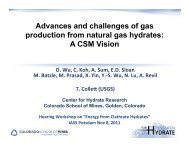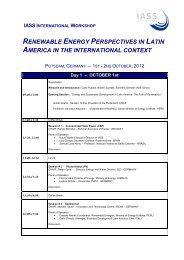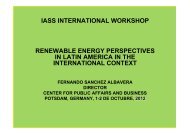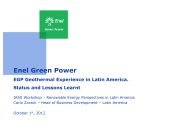G.K. Surya Prakash - IASS Potsdam
G.K. Surya Prakash - IASS Potsdam
G.K. Surya Prakash - IASS Potsdam
Create successful ePaper yourself
Turn your PDF publications into a flip-book with our unique Google optimized e-Paper software.
The Methanol Economy<br />
G. K. <strong>Surya</strong> <strong>Prakash</strong><br />
Loker Hydrocarbon Research Institute<br />
and<br />
Department of Chemistry<br />
University of Southern California<br />
Los Angeles, CA 90089-1661<br />
USA<br />
Sustainable Methanol: An Alternative Green<br />
Fuel for the Future Workshop<br />
<strong>IASS</strong> <strong>Potsdam</strong>, Germany<br />
November 22-23, 2011
World population<br />
(in millions)<br />
1650 1750 1800 1850 1900 1920 1952 2000<br />
Projection<br />
2050 *<br />
545 728 906 1171 1608 1813 2409 6200 8000 to 11000<br />
* Medium estimate. Source: United Nations, Population Division<br />
200<br />
180<br />
160<br />
140<br />
120<br />
100<br />
80<br />
60<br />
Petawatt-hours (10 15 watt-hours)<br />
History<br />
91<br />
84<br />
71<br />
61<br />
102<br />
107<br />
121<br />
Projections<br />
148<br />
162<br />
175<br />
189<br />
v 150 petawatt-hours ~ 15 terawatts<br />
(15,000 power plants of 1 gigawatt) <br />
v 21 TW by 2025<br />
v 30 TW by 2050<br />
40<br />
20<br />
0<br />
1970 1975 1980 1985 1990 1995 2002 2010 2015 2020 2025<br />
World Primary Energy Consumption, 1970 to 2025 <br />
Based on data from Energy information Administration (EIA)
More than 80% of our<br />
energy comes from<br />
fossil fuels<br />
Oil<br />
34.4%<br />
Coal<br />
26.0%<br />
Other<br />
0.6%<br />
Combustible<br />
Renewables &<br />
Waste<br />
10.1%<br />
Hydro<br />
2.2%<br />
Nuclear<br />
6.2%<br />
Natural gas<br />
20.5%<br />
Total 11 741 Mtoe<br />
Distribution of the World Total Primary Energy Supply in 2006. <br />
Based on data from the International Energy Agency (IEA)<br />
Key World Energy Statistics 2008
Increasing world population<br />
Increase in standard of living <br />
Increase in fossil fuel use <br />
- Oil, gas, coal (hydrocarbons) <br />
Finite sources – non-renewable <br />
On the human timescale <br />
Increase in carbon dioxide <br />
content of the atmosphere <br />
Greenhouse effect<br />
(Global warming). 390 ppm
Hydrocarbon Sources<br />
17 th -19th Century - industrial revolution coal<br />
19 th Century coal, oil <br />
20 th Century coal, oil, natural gas <br />
(fossil fuels) <br />
21 st Century fossil fuels <br />
carbon dioxide
Petroleum products<br />
In United States, 67% of the<br />
petroleum is currently used<br />
in transportation as gasoline,<br />
diesel, jet fuel, etc.! <br />
Transportation sector is<br />
utterly dependant on<br />
petroleum oil
Proven Oil and Natural Gas Reserves<br />
(in billion tonnes of oil equivalent) from 1960 to 2003<br />
Year Oil Natural Gas<br />
1960 43 15.3<br />
1965 50 22.4<br />
1970 77.7 33.3<br />
1975 87.4 55<br />
1980 90.6 69.8<br />
1986 95.2 86.9<br />
1987 121.2 91.4<br />
1988 123.8 95.2<br />
1989 136.8 96.2<br />
1990 136.5 107.5<br />
1993 139.6 127<br />
2002 156.4 157.6<br />
2003 156.7 158.2
Oil and Natural Gas Reserve to Production<br />
(R/P) Ratio<br />
70<br />
Oil<br />
Natural gas<br />
60<br />
50<br />
R/P Ratio (years)<br />
40<br />
30<br />
20<br />
10<br />
0<br />
1980<br />
1982<br />
1984<br />
1986<br />
1988<br />
1990<br />
1992<br />
1994<br />
1996<br />
1998<br />
2000<br />
2002<br />
2004
Regional Distribution of World Oil Reserves in 2004<br />
Asia, 3.5% Middle East, 61.7%<br />
North America, 5.1%<br />
South and Central America,<br />
8.5%<br />
Africa, 9.4%<br />
Europe and Eurasia, 11.7%<br />
Saudi Arabia, 22.1%<br />
Iran, 11.1%<br />
Iraq, 9.7%<br />
Kuwait, 8.3%<br />
United Arab Emirate, 8.2%<br />
Others, 2.3%<br />
Total: 1189 billion barrels
Distribution of World Natural Gas Proven<br />
Reserves in 2004<br />
Russia<br />
26.7%<br />
Eurasia<br />
5.1%<br />
Europe<br />
3.8%<br />
Asia<br />
7.9%<br />
Africa<br />
7.8%<br />
North America<br />
4.1%<br />
South and Central<br />
America<br />
4.0%<br />
Qatar<br />
14.4%<br />
Rest of Middle East<br />
10.9%<br />
Iran<br />
15.3%<br />
Total: 180 trillion m 3<br />
About 67% of the natural gas reserves<br />
are in Middle East and Russia
Coal<br />
World Proven Coal Reserves Distribution<br />
India, 10%<br />
China, 12%<br />
Australia, 9%<br />
South Africa , 5%<br />
Ukraine, 4%<br />
Russia, 17%<br />
Kazakhstan, 3%<br />
Rest of the World,<br />
12%<br />
United States , 27%<br />
Total Proven Reserves: 909,000 Mt <br />
Enough for more than 160 years at current rate of consumption!<br />
Coal is a dirty fuel. It also emits much more CO 2 per unit of energy<br />
produced than petroleum and natural gas
Non-conventional fossil fuels<br />
Already exploited<br />
To be developed <br />
• Tar sands <br />
Exploited on a large scale in Canada (2 million barrels /day)<br />
• Tight gas sands and shale<br />
Already accounts for 15% of the natural gas production in US<br />
• Coalbed methane <br />
Currently represents about 10% of the natural gas production in US<br />
• Oil shale<br />
• Methane hydrates <br />
Both have large potential but ways to exploit them economically <br />
have to be found
Annual Global CO 2 Emissions- 1750-2005 <br />
Total<br />
Coal<br />
Petroleum<br />
Natural gas<br />
Cement production<br />
Gas flaring<br />
35,000<br />
30,000<br />
25,000<br />
20,000<br />
15,000<br />
10,000<br />
5,000<br />
Million tonnes carbon dioxide / year<br />
1750 1800 1850 1900 1950 2000<br />
-<br />
Source: Carbon Dioxide Information Analysis Center, Oak Ridge national Laboratory
Worldwide contribution of greenhouse gases to the<br />
increased greenhouse effect induced by human activity<br />
Nitrous oxide<br />
6%<br />
Halogenated<br />
compounds<br />
10%<br />
Methane<br />
19%<br />
Carbon dioxide<br />
65%<br />
Global Warming Potentials (GWPs) of greenhouse gases<br />
Global warming potential<br />
Carbon dioxide CO 2<br />
1<br />
a<br />
Atmospheric lifetime<br />
(years)<br />
Methane CH 4 23 12<br />
Nitrous oxide N 2 O 296 114<br />
Hydrofluorocarbons (HFC) 12-12,000 0.3-260<br />
Examples:<br />
HFC-23 CHF 3<br />
12,000 260<br />
HFC-32 CH 2F 2<br />
550 5<br />
HFC-134a CH 2<br />
FCF 3<br />
1,300 14<br />
Fully fluorinated species 5,700-22,200 2,600-50,000<br />
Examples:<br />
Perfluoromethane CF 4<br />
5,700 50,000<br />
Perfluoroethane C 2<br />
F 6<br />
11,900 10,000<br />
Sulfur hexafluoride SF 6<br />
22,200 3,200<br />
a Over a 100 year time horizon<br />
Based on data from IPCC, Third Assessment Report, 2001
Daily usage of fossil fuels<br />
v 85 Million Barrels of Oil is consumed! <br />
v 8 Billion m 3 of Natural Gas<br />
v 16 Million Tonnes of Coal <br />
30 billion tonnes of CO 2 released into the atmosphere per year <br />
Contributing to greenhouse effect – Global Warming<br />
Ethanol economy: in the US, 7 billion gallons of ethanol is<br />
produced per year (~175 million barrels) from corn.<br />
Equivalent to 115 million barrels of oil: 1.3 days supply!<br />
In Brazil, 7 billion gallons of ethanol from sugar cane is <br />
Produced <br />
Biodiesel a lot smaller: requires more land
Biomass<br />
CO 2 fixation by photosynthesis (carbon neutral)<br />
CO 2 Fixation by Photosynthesis (carbon neutral)<br />
nCO 2<br />
+ nH 2 O<br />
Biofuels- Ethanol, butanol, vegetable oils (biodiesel)- a small %<br />
of the energy mix.<br />
* Land availability and use<br />
* Water resources- Irrigation<br />
* Food security vs Energy security<br />
* Fertilzer use (nitrogen fertilizers from NH 3 (N 2 and H 2 (syngas))<br />
* Processing technologies, energy use<br />
* Overall energy balance<br />
Chlorophyll<br />
Sunlight<br />
n(CH 2 O) + nO 2<br />
Sun is the source of most energy on Earth- past, present and future<br />
130,000 TW continuous- A reliable nuclear fusion reactor!
Alternative Energies<br />
Hydropower <br />
Geothermal energy<br />
Wind energy<br />
Solar energy <br />
Biomass <br />
Ocean energy (waves, tides, thermal) <br />
Nuclear energy
Electric Energy Generated in Industrial Countries by Non-Fossil Fuels (%, 2004)<br />
Country<br />
Fossil Fuels Hydroelectric Nuclear<br />
Geothermal, Solar, Wind,<br />
Wood and Waste<br />
Total<br />
Non-Fossil<br />
France<br />
9.4<br />
10.9<br />
78.6<br />
1.1<br />
90.6<br />
Canada<br />
25.7<br />
58.0<br />
14.7<br />
1.6<br />
74.3<br />
Germany<br />
61.9<br />
3.6<br />
27.5<br />
6.9<br />
38.1<br />
Japan<br />
62.2<br />
9.2<br />
26.4<br />
2.2<br />
37.8<br />
South Korea<br />
62.8<br />
1.2<br />
35.9<br />
0.1<br />
37.2<br />
United States<br />
71.0<br />
6.7<br />
19.8<br />
2.4<br />
29.0<br />
United Kingdom<br />
75.5<br />
1.3<br />
20.0<br />
3.2<br />
24.5<br />
Italy<br />
81.1<br />
14.1<br />
0.0<br />
4.8<br />
18.9<br />
Source: Energy Information Administration, International Energy Annual 2007,<br />
World Net Electricity Generation by Type, 2004
Energy Storage<br />
Most of the alternative energies (solar, wind, geothermal,<br />
nuclear) produce electricity ; solar and wind are intermittant<br />
Problem: How to store electricity in a convenient<br />
form and on a large scale<br />
• Batteries: Low capacity<br />
• Fly wheel<br />
• Water<br />
Limited capacity<br />
• Compressed air<br />
• In a liquid or gas: Hydrogen, Methanol, etc.<br />
If it was easy to store electricity, we would all be <br />
driving electric cars!
Hydrogen Economy<br />
Hydrogen economy (clean fuels, fuel cells)<br />
• Hydrogen is not a primary energy carrier, b.p. = -253 °C <br />
• Tied up in water and fossil fuels<br />
• Incompatible with 20% oxygen in the air<br />
• Liquid hydrogen has 1/3 Volumetric energy density of gasoline <br />
• 2 grams occupy 22.4 liters of volume at NTP (high pressurization <br />
is required) <br />
• Infrastructure is very expensive (hydrogen diffuses easily) <br />
• Highly flammable (colorless flame)
Carbon Conundrum<br />
Environmental effect<br />
Essential element for<br />
terrestrial life<br />
Excessive CO 2 production<br />
contributes to global warming<br />
Burning of fossil fuels, living<br />
organisms<br />
Natural and industrial sources (natural<br />
gas production, geothermal wells,<br />
varied industries)<br />
Nature's carbon cycle<br />
Limited fossil fuel resources are<br />
increasingly depleted<br />
Nature's carbon cycle takes a long<br />
time. Technological CO 2 recycling via<br />
Methanol Economy is a possibility
The Methanol Economy
Methanol, fuel and feed-stock: The Methanol Economy<br />
CH 3 OCH 3 , high cetane <br />
clean burning diesel fuel, LNG<br />
and LPG substitute. <br />
In Internal<br />
Combustion<br />
Engines<br />
High octane (ON= 100) <br />
clean burning fuel, <br />
15.8 MJ/liter.<br />
M-85 Fuel <br />
As Dimethyl<br />
Ether (Diesel<br />
Fuel,<br />
Household<br />
Fuel)<br />
CH 3 OH<br />
In Direct<br />
Methanol<br />
Fuel Cells<br />
Conversion<br />
to olefinsgasoline,<br />
diesel, etc.
Methanol properties<br />
v Methanol (methyl alcohol, wood alcohol) is an excellent internal<br />
combustion engine/turbine fuel- It is a liquid (b.p 64.7 o C). <br />
v Methanol has a high octane number (~ 100)- used in Race cars. <br />
v M85- used in Flex-Fuel vehicles (similar to E-85). <br />
v Half the volumetric energy content of gasoline (15.8 MJ/liter),<br />
but more efficient and cleaner burning. <br />
v Methanol can be blended into Biodiesel (Esterification).<br />
Converted to dimethyl ether and dimethyl carbonate. <br />
v Methanol is an excellent hydrogen carrier -easily reformed to H 2<br />
(syngas) at modest temperatures.
Methanol in ICE<br />
v Octane number 100- fuel/air mixture can be<br />
compressed to smaller volume-results in higher<br />
compression ratio <br />
v Methanol has also has higher flame speedhigher<br />
efficiency <br />
v Higher latent heat of vaporization (3.7 times<br />
higher than gasoline)- can absorb heat betterremoves<br />
heat from engine- air cooled engines <br />
v Methanol burns better- cleaner emissions <br />
v Safer fuel in fires than gasoline <br />
v Methanol can be dispensed in regular gas<br />
station requiring only limited modifications <br />
v Compatible with hybrid (fuel/electric) systems
Drawbacks<br />
v Methanol is miscible in water - corrosive for Al, Zn, Mg <br />
Solution: use compatible materials - Flexfuel vehicles <br />
v Methanol has low vapor pressure at low temperatures <br />
Solution: spike it with gasoline- M85 <br />
v Ingestion > 20 mL can be lethal - Dispensing should not be <br />
a problem <br />
v Spillage - very safe to the environment <br />
methanol used in water treatment plants for denitrification
Dimethyl ether (DME)<br />
2CH 3 OH<br />
- H 2 O<br />
CH 3 OCH 3<br />
b.p. -24.8 °C; m.p. -141 °C <br />
v Excellent diesel fuel substitute with <br />
a cetane number of 55-60 (45-55 for<br />
regular diesel) and very clean burning<br />
v Already used in spray dispenser <br />
v Non-toxic, Safe and does not form <br />
peroxides <br />
v Substitute for LNG and LPG<br />
v Easy to produce, ship and dispense<br />
v Sootless flame for glass blowing<br />
DME truck in Japan<br />
DME bus in Denmark
Advanced methanol-powered<br />
fuel cell vehicles<br />
On-board generation of hydrogen through methanol reforming<br />
CH 3 OH <br />
+ H 2 O <br />
Reforming<br />
Catalyst <br />
H 2 + CO 2<br />
Proton Exchange<br />
membrane (PEM) <br />
Fuel cell<br />
H 2 O<br />
Methanol has no C-C bonds: reforming at low<br />
temperatures (250-300 °C)<br />
Avoids the problem of on-board<br />
hydrogen storage under high<br />
pressure or in cryogenic liquid form<br />
(-253 °C)
Direct oxidation methanol fuel cell<br />
Direct Oxidation Methanol Fuel Cell<br />
(DMFC) USC, JPL - Caltech<br />
e -<br />
e -<br />
e - - +<br />
Anodic Reaction: <br />
CH 3 OH + H 2 O Pt-Ru (50:50) CO 2 + 6 H + + 6 e - <br />
CH 3<br />
OH<br />
+ H 2<br />
O<br />
H +<br />
H +<br />
H +<br />
O 2<br />
/ Air<br />
Cathodic Reaction: <br />
E o = 0.006 V <br />
3/2 O 2 + 6 H + + 6 e - Pt <br />
3 H 2 O <br />
CO 2<br />
+ H 2<br />
O<br />
Anode<br />
Pt -Ru<br />
catalyst layer<br />
-<br />
H +<br />
+<br />
Cathode<br />
Pt<br />
catalyst layer<br />
H 2<br />
O<br />
Overall Reaction: <br />
CH 3 OH + 3/2 O 2 <br />
E o = 1.22 V <br />
CO 2 + H 2 O <br />
+ electricity<br />
E cell = 1.214 V <br />
Proton Exchange<br />
membrane<br />
(Nafion-H)<br />
US Patent, 5,599,638, February 4, 1997; Eur. Patent 0755 576 B1, March 5, 2008.
Direct Methanol Fuel Cell<br />
Advantages<br />
v Methanol, 5 kWh/Liter – Theoretical (2 X Hydrogen) <br />
v Absence of Pollutants<br />
H 2 O and CO 2 are the only byproducts <br />
v Direct reaction of methanol eliminates reforming <br />
Reduces stack and system complexity<br />
Silent, no moving parts <br />
v Capable of start-up and operation at 20 °C and below <br />
Thermally silent, good for military applications<br />
v Liquid feed of reactants <br />
Effective heat removal and thermal management<br />
Liquid flow avoids polymer dryout <br />
Convenient fuel storage and logistic fuel
Methanol as a fuel and feedstock<br />
* Electricity production by combustion in existing gas turbines <br />
* Electricity generation through fuel cells<br />
Fuel cells not limited by weight and space: other types of fuel cells can be<br />
used; PAFC, MCFC and SOFC<br />
* Use of methanol as cooking fuel in developing countries <br />
Much cleaner burning and efficient than wood <br />
* Methanol is a feed for single cell proteins- as a feed for animals
METHANOL AS HYDROCARBON SOURCE<br />
-2H 2 O<br />
2CH 3 OH CH 2 CH 2 CH 3 CH CH 2<br />
Zeolites<br />
or bifunctional<br />
catalysts<br />
HYDROCARBON FUELS AND PRODUCTS<br />
(Gasoline, Diesel, etc.)
CH 3 OH Sources<br />
Industrial production<br />
Natural occurance<br />
Syn-gas (from coal or natural gas)<br />
Direct methane conversion<br />
Carbon dioxide reduction<br />
Wood, Biological processes<br />
(microbial or enzymatic<br />
transformations )<br />
Recently discovered enormous<br />
galactical methanol clouds
CH 3 OH from syn-gas<br />
Syn-gas is a mixture of H 2 , CO and CO 2 <br />
CO + 2H 2 CH 3 OH<br />
CO 2<br />
+ 3H 2 CH 3 OH + H 2 O<br />
H 298K = - 21.7 kcal / mol<br />
H 298K = - 11.9 kcal / mol<br />
CO + H 2 O CO 2<br />
+ H 2<br />
H 298K = - 9.8 kcal / mol<br />
S<br />
=<br />
moles H 2<br />
moles CO<br />
S=2 ideal for methanol<br />
Syn-gas can be produced from any source of carbon: natural gas,<br />
petroleum, coal, biomass, etc. <br />
However, not all give an ideal S ratio for methanol synthesis
CH 3 OH from methane<br />
v Syn-gas from natural gas – steam reforming <br />
Ni Cat.<br />
CH 4 + H 2 O CO + 3H 2<br />
H 298K = 49.1 kcal / mol<br />
Excess H 2 generally used for ammonia (NH 3 ) production<br />
S=3 <br />
v Partial oxidation of methane <br />
CH 4 + 1/2 O 2 CO + 2H 2<br />
1/2 O 2<br />
H 298K = - 8.6 kcal / mol<br />
S=2 <br />
CO<br />
+<br />
CO 2<br />
H 298K = - 67.6 kcal / mol<br />
H 2<br />
+ 1/2 O 2<br />
H 2 O<br />
H 298K = - 57.7 kcal / mol<br />
v Dry reforming with CO 2 <br />
CO 2<br />
Ni Cat.<br />
+ CH 4 2CO + 2H 2<br />
H 298K = 59.1 kcal / mol<br />
S=1 <br />
Reactions occur at high temperatures (at least 800-1000 °C)
CH 3 OH through bi-reforming<br />
Combination of steam and dry reforming: bi-reforming<br />
+ 2CO<br />
2CH 4 2H 2 O + 6H 2<br />
CO 2<br />
+ CH 4 2CO + 2H 2<br />
Overall:<br />
3CH 4 + 2H 2 O + CO 2 4CO + 8H 2<br />
4CH 3 OH
CH 3 OH from coal<br />
A proven technology<br />
3C + 3/2 O 2<br />
Catalysts<br />
3CO<br />
2CO + 2H 2 O<br />
2CO 2 + 2H 2<br />
CO +2H 2<br />
CH 3 OH<br />
3C + 2H 2 O + 3/2 O 2<br />
2CO 2 + CH 3 OH<br />
China is currently adopting this approach on a massive scale <br />
based on its large coal reserves<br />
100 plants in construction or planned!<br />
Due to the low H/C ratio of coal: a lot of CO 2 is produced!
CH 3 OH through methane<br />
halogenation<br />
Br 2 + H 2 O<br />
CH 4<br />
Br 2<br />
O 2<br />
Solid or liquid acids<br />
CH 3 Br + HBr<br />
H 2 O<br />
CH 3 OH (or CH 3 OCH 3 ) + HBr<br />
Overall reaction:<br />
CH 4 + 1/2 O 2 CH 3 OH
CH 3 OH through intermediates other<br />
than syn-gas<br />
Homogeneous catalyst<br />
Pt, Hg, Au based<br />
CH 4 + 2H 2 SO 4 CH 3 OSO 3 H + 2H 2 O + SO 2<br />
CH 3 OSO 3 H + H 2 O CH 3 OH + H 2 SO 4<br />
SO 2 + 1/2 O 2 + H 2 O H 2 SO 4<br />
CH 4 + 1/2 O 2 CH 3 OH (Overall reaction)<br />
Advantage: low temperature reaction (180-250 °C),<br />
much lower than syn-gas generation (800-1000 ° C) <br />
Inconvenient: need to recycle concentrated and corrosive H 2 SO 4
CH 3 OH from methane without CO 2<br />
production<br />
Methane decomposition:<br />
Methanol synthesis:<br />
~ 900 o C<br />
CH 4 C + 2H 2<br />
CO 2 + 3H 2<br />
CH 3 OH + H 2 O<br />
Overall reaction:<br />
3CH 4 + 2CO 2<br />
2CH 3 OH + 2H 2 O + 3C<br />
Advantage: all the carbon in methane ends up in carbon, a solid<br />
which is easy to handle and store<br />
We could make extensive use of our natural gas reserves without<br />
CO 2 emissions
Methanol from biomass<br />
• Biomass includes any type of plant or animal material:<br />
Wood, wood wastes, agricultural crops and by-products, municipal waste, animal waste, aquatic<br />
plants and algae, etc.<br />
• Transformed to methanol by gasification through syngas- very efficient<br />
Biomass<br />
Syn-gas<br />
CO + H 2<br />
• Any biomass is fine to make methanol<br />
• Large amount of biomass needed- can convert biomass to<br />
biocrude and it can be shipped.<br />
Methanol<br />
• Methanol from Biogas (mixture of CH 4 , CO 2 )<br />
• Methanol through aquatic biomass- micro-algae<br />
Biocrude <br />
Biomass alone can not fulfill all our increasing energy needs
Biomass to Liquids (Methanol)<br />
Lignocellulose<br />
Fast Pyrolysis, 550 o C<br />
Condensate + Char + Slurry, 90%<br />
Gasification with Oxygen, 1200 o C<br />
CO + H 2 Syngas, 78%<br />
Methanol or other liquids
Efficient Ways to Capture CO 2 and Its Electrochemical Conversion<br />
Why Focus on Carbon Dioxide<br />
• Linear molecule<br />
• Very stable<br />
– Hard to efficiently reduce<br />
• Trace gas<br />
– 0.039% of the atmosphere<br />
– Amount of CO 2 in the atmosphere is increasing<br />
• With declining fossil fuel reserves, CO 2 may become the<br />
best source of carbon<br />
US Patent, 7,605, 293, October, 20, 2009 <br />
US Patent, 7,608, 743, October, 27, 2009
Sour ces of CO 2<br />
Geothermal Vents<br />
Fermentation Processes<br />
Natural Gas Wells<br />
Cement Plants<br />
Fossil Fuel Burning Power Plants<br />
Aluminum Plants<br />
Air Itself
Electrochemical Reduction of CO 2 to Syngas and Formic Acid<br />
Standard Electrochemical Reduction Potentials of CO 2 at pH=7, NHE, NTP Conditions <br />
CO 2 e - + CO 2 E o = -1.96 V (1)<br />
CO 2 + 2H + + 2e - CO + H 2 O E o = -0.53 V (2)<br />
CO 2 + 2H + + 2e - HCOOH E o = -0.61 V (3)<br />
CO 2 + 4H + + 4e - HCHO + H 2 O E o = -0.48 V (4)<br />
CO 2 + 6H + + 6e - CH 3 OH + H E o 2 O = -0.38 V (5)<br />
CO 2 + 8H + + 8e - CH E o 4 + 2H 2 O = -0.24 V (6)<br />
O<br />
H<br />
OCH 3<br />
H 2 O + CO<br />
O<br />
H OH<br />
A Fuel &<br />
Feed-stock<br />
MeOH<br />
H 2 + CO 2<br />
Direct Formic Acid Fuel Cell
Solar Thermal Conversions<br />
CO 2 + 3 FeO CO + Fe 3 O 4<br />
Fe 3 O 4 3 FeO + 1/2 O 2<br />
Overall<br />
CO 2<br />
CO + 1/2 O 2<br />
Sunshine to Petrol: Sandia National Laboratory Project
Methanol from CO 2<br />
imitating nature<br />
Sources of carbon dioxide: <br />
• Industrial flue gases: Fossil fuel burning power plants, steel and cement<br />
factories, etc. <br />
• The atmosphere itself (390 ppm)<br />
Hydrogenation of CO 2<br />
CO 2<br />
+ 3H 2<br />
CH 3 OH + H 2 O<br />
Electrochemical reduction of CO 2<br />
Electrons<br />
CO 2<br />
+ 2H 2 O<br />
Electrode catalyst<br />
CO + 2H 2 +<br />
3/2 O 2<br />
CH 3 OH<br />
Electricity needed to produce hydrogen or for the reduction can come<br />
from any renewable (wind, solar, etc.) or nuclear energy source<br />
US Patent, 7,704,369, April 27, 2010
Chemical Recycling of CO 2<br />
CO 2 Capture:<br />
Solution absorption and membrane technologies,<br />
nanostructured supported amino polymer absorbent systemconvenient<br />
revesible absorption and desorption- USC Technology<br />
Water Electrolysis<br />
H 2 O H 2 + 1/2 O 2<br />
Overall Cu/Zn catalysts<br />
CO 2 + 3H 2<br />
CH 3 OH + H 2 O<br />
Methane Bireforming:<br />
3CH 4 + 2H 2 O + CO 2<br />
3CH 4 + CO 2 2 CH 3 OCH 3<br />
<br />
Hydrogen Generation: Photochemical, thermal or electrochemical means<br />
Overall<br />
Catalyst<br />
endothermic<br />
4 CH 3 OH<br />
CRI in Iceland,<br />
using their cheap<br />
geothermal energy!<br />
2 CH 3 OCH 3 +<br />
2 H 2 O
US Patent, 5,928,806, July 27, 1999
Carbon Capture and Recycling (CCR)<br />
Basis of the Methanol Economy<br />
Renders carbon containing fuels and products environmetally<br />
neutral<br />
Provides sustainable, universally available regenerative<br />
carbon source via carbon dioxide recycling using any energy<br />
source (alternates with emphasis on solar and atomic) and<br />
hydrogen of water<br />
Replaces diminishing fossil fuels freeing humanity from<br />
dependence on coal, oil and natural gas<br />
Offering solution to the costly and potentially dangerous<br />
carbon capture and storage (CCS)
The Methanol Economy
Worldwide Development of the Methanol Economy<br />
USC - Honeywell - UOP: Concepts, new enabling chemistry and<br />
technology, IP and licencing<br />
Iceland: First geothermal CO 2 conversion plant to methanol<br />
(George Olah Renewable Methanol Plant, Carbon Recycling Int.)<br />
Japan: Industrial CO 2 to methanol demonstration plant (Mitsui)<br />
China: Major low carbon technology energy initiative includes<br />
carbon capture, storage or recycling of CO 2 from coal burning<br />
power plants (Government, CAS, Industry)<br />
China, Japan, South Korea: Operating and building 50-100 multimillion<br />
t/yr coal or natural gas based methanol and DME plants<br />
with CO 2 capture, storage or recycling to be added
CRI Carbon Recycling International<br />
George Olah CO 2 to Renewable Methanol Plant Groundbreaking<br />
HS Orka Svartsengi Geothermal Power Plant, Iceland, October 17 th 2009 <br />
Production capacity: 10 t/day, planned expansion to 100 t/day <br />
geothermal CO 2<br />
+ 3H 2<br />
H 2 O<br />
US Patents 7,605,293 and 7,608,743 <br />
Int. Pat. Appl., WO2010011504 A2 January 28, 2010 <br />
CH 3 OH + H 2 O<br />
electrolysis using<br />
geothermal electricity
Acknowledgments<br />
Professor G. A. Olah<br />
Robert Aniszfeld<br />
Patrice Batamack<br />
Carlos Colmenares<br />
Alain Goeppert<br />
Thomas Mathew<br />
Sergio Meth<br />
Suresh Palale<br />
Federico Viva<br />
$$$$<br />
USC-Loker Institute<br />
US Dept. of Energy<br />
Universal Oil Products (UOP)




